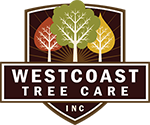Extreme weather events happen all over the world and in every part of the country. Whether it’s storms, drought or flooding, extreme weather can have a lasting impact on your Portland trees. Once the wind or rain has stopped it takes time for trees to fully recover. During these times, the trees on your property are under a tremendous amount of stress.
Depending on the situation, the foliage of a tree can decline or dieback can occur resulting in broken branches or deadwood. Even more, serious structural damage (visible or undetected), can increase the likelihood of failure resulting in potential harm or property damage.
That’s why it’s important to monitor the trees on your property, especially during periods of extreme weather with the following inspection guide Westcoast Tree Care has put together.
Storm Damage
Seasonal storms threaten the health, safety, and beauty of trees. When major damage occurs, immediate action by a certified arborist is often needed. Pruning or the removal of a tree that poses risks to people or property must be prioritized following a storm. Though your landscape may seem to return to normal, the lingering effects of a storm often impact the health, appearance, and structural integrity of your trees later on.
Broken branches, cracks, and deadwood can not only become unpredictable but serve as an entry point for unwanted pests and disease. The larger the wound, the less likely a tree will heal, making it a hazardous risk to people and property below.
Storm Tree Care
- Hire a certified arborist to prune or remove any dead, damaged or broken branches.
- Inspect your trees for any signs of root damage, especially if a tree has developed a sudden lean.
- Keep a close eye out for signs of unwanted pests and disease.
Drought Damage
The health and safety of a tree can be seriously impacted due to a drought. Water is an essential element trees need to survive and grow. Lack of water impacts a tree’s ability to manufacture food, thus weakening it and limiting its future growth.
Dry soil results in root dieback. Roots are essential for transporting water and nutrients to the tree. Even when water and moisture are restored a tree will not be able to take full advantage due to damage or loss of its roots. Even worse, drought-stressed trees often become an easy target for insect infestations and disease.
Drought Tree Care
- Irrigate trees regularly especially during the summer and autumn months.
- Conserve water and improve soil conditions by applying a layer of organic mulch around the base of a tree.
- Recharge the soil by fertilizing during the autumn or spring. However, a tree must be receiving adequate water before it is fertilized.
- Monitor trees for unwanted insect infestations and signs of disease.
Flood Damage
Flood water can seriously impact the health and integrity of trees. Even after a flood has subsided, soil can retain excessive water for long periods of time. This can result in a reduced supply of oxygen to the roots of tree. Sediment or shifting of soil can further exacerbate the situation, creating a challenging growing environment for the roots of a tree. Disease can also thrive in wet conditions, causing a tree to rapidly decline.
Another main concern is damage and dieback of a trees root system. If a trees root system becomes damaged a tree can become sick or die once the water has receded. Even worse, the structural stability of a tree can become compromised since its roots serve as an anchor to keep the tree upright and vertical.
Flood Tree Care
- Improve drainage in flood-prone areas.
- Have your soil analyzed by a professional to ensure proper pH and fertilizer conditions.
- Apply a thin layer of mulch just off the trunk of a tree once flooding has subsided.
Portland Tree Care
When it comes to the safety of you and your loved ones, it’s important to monitor the health and safety of your trees before extreme weather sets in. At Westcoast Tree Care, we work hard to make sure the trees on your property are healthy, well-maintained and as safe as possible. We can evaluate your trees and help minimize any potential safety hazards by keeping them pruned and cared for.
If you suspect a tree on your property might fail during extreme weather, it’s important to have it inspected by a tree care professional. Our certified arborist would be more than happy answer any questions you may have and look over your property while providing you with a no-cost, no-obligation quote.
Contact us at 1.800.767.8733 (TREE).








